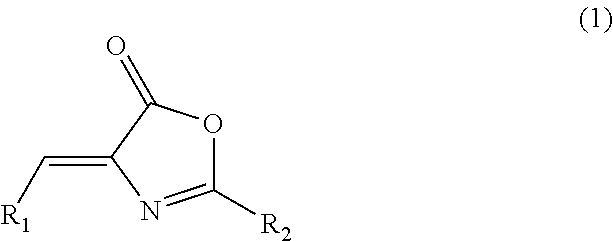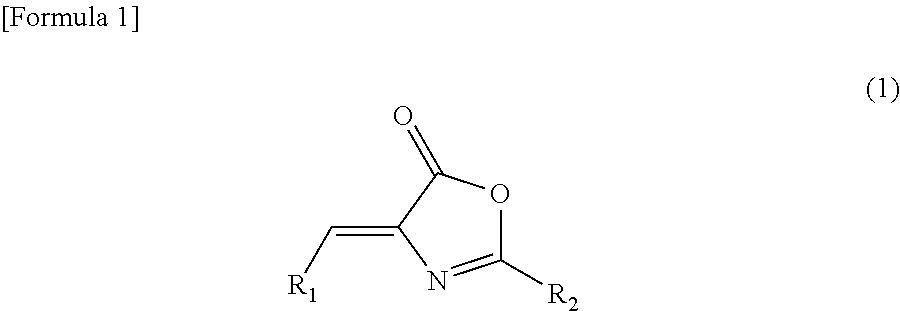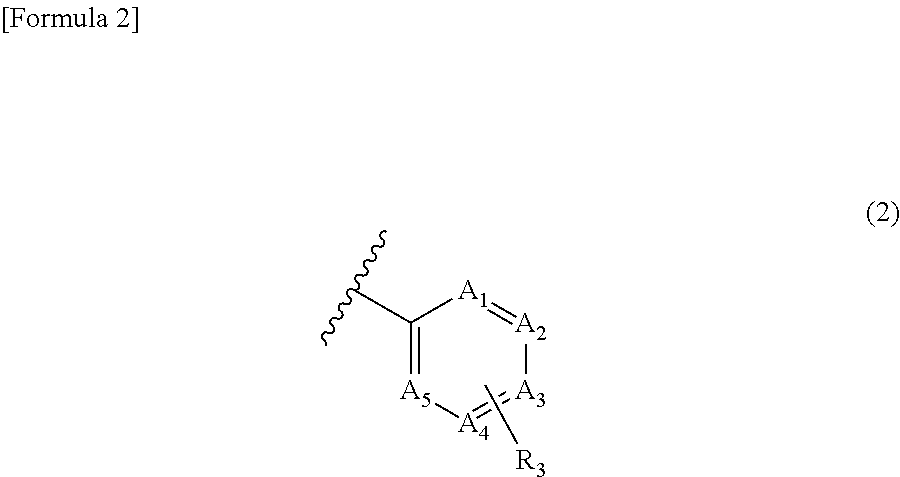Inhibitor of casein kinase 1δ and casein kinase 1ε
a technology of casein kinase and inhibitor, which is applied in the direction of biocide, cardiovascular disorder, drug composition, etc., can solve the problems of drug therapy, which is based on the technique, and the development of drugs for improving the circadian rhythm sleep disorder has not yet been completed, so as to achieve the effect of inhibiting activities, high selectivity and high clinical efficiency
- Summary
- Abstract
- Description
- Claims
- Application Information
AI Technical Summary
Benefits of technology
Problems solved by technology
Method used
Image
Examples
example 1
4-((5-Methoxy-3-pyridinyl)methylene)-2-(5-methyl-2-thienyl)-5(4H)-oxazolone
[0138]
[0139]To a screw-capped test tube, N-[(5-methyl-2-thienyl)carbonyl]glycine (60 mg, 0.3 mmol), 5-methoxy-3-pyridinecarboxaldehyde (45 mg, 0.3 mmol), sodium acetate (25 mg, 0.3 mmol) and acetic anhydride (0.3 mL) were added. The test tube was sealed, and it was then stirred at an external temperature of 90° C. Three hours later, the temperature of the reaction solution was returned to room temperature, and water (1.5 mL) was then added thereto. The obtained mixture was stirred at the same temperature as described above for 1.5 hours. Thereafter, the precipitated crystal was collected by filtration, and it was washed with water (5 mL) and was then dried under reduced pressure, so as to obtain 51 mg of the above-captioned compound.
[0140]1H-NMR (400 MHz, DMSO-d6, δ).
[0141]8.83 (s, 1H), 8.36 (s, 1H), 8.31 (s, 1H), 7.84 (d, J=3.7 Hz, 1H), 7.28 (s, 1H), 7.09 (d, J=3.7 Hz, 1H), 3.91 (s, 3H), 2.60 (s, 3H).
[0142]E...
example 2
4-((5-Methoxy-3-pyridinyl)methylene)-2-(2-thienyl)-5(4H)-oxazolone
[0143]
[0144]To a screw-capped test tube, N-(2-thienylcarbonyl)glycine (56 mg, 0.3 mmol), 5-methoxy-3-pyridinecarboxaldehyde (45 mg, 0.3 mmol), sodium acetate (25 mg, 0.3 mmol) and acetic anhydride (0.3 mL) were added. The test tube was sealed, and it was then stirred at an external temperature of 90° C. Three hours later, the temperature of the reaction solution was returned to room temperature, and water (1.5 mL) was then added thereto. The obtained mixture was stirred at the same temperature as described above for 1.5 hours. Thereafter, the precipitated crystal was collected by filtration, and it was washed with water (5 mL) and was then dried under reduced pressure, so as to obtain 40 mg of the above-captioned compound.
[0145]1H-NMR (400 MHz, DMSO-d6, δ).
[0146]8.86 (s, 1H), 8.38 (s, 1H), 8.32 (s, 1H), 8.16 (d, J=4.9 Hz, 1H), 8.02 (d, J=3.8 Hz, 1H), 7.37 (dd, J=4.8, 3.9 Hz, 1H), 7.34 (s, 1H), 3.92 (s, 3H).
[0147]ESI-M...
example 3
4-((5-Fluoro-3-pyridinyl)methylene)-2-(2-thienyl)-5(4H)-oxazolone
[0148]
[0149]To a screw-capped test tube, N-(2-thienylcarbonyl)glycine (56 mg, 0.3 mmol), 5-fluoro-3-pyridinecarboxaldehyde (41 mg, 0.3 mmol), sodium acetate (25 mg, 0.3 mmol) and acetic anhydride (0.3 mL) were added. The test tube was sealed, and it was then stirred at an external temperature of 90° C. Three hours later, the temperature of the reaction solution was returned to room temperature, and water (1.5 mL) was then added thereto. The obtained mixture was stirred at the same temperature as described above for 1.5 hours. Thereafter, the precipitated crystal was collected by filtration, and it was washed with water (5 mL) and was then dried under reduced pressure, so as to obtain 56 mg of the above-captioned compound.
[0150]1H-NMR (400 MHz, DMSO-d6, δ).
[0151]9.13 (s, 1H), 8.67 (s, 1H), 8.53 (s, 1H), 8.20 (d, J=4.8 Hz, 1H), 8.06 (d, J=3.8 Hz, 1H), 7.37 (dd, J=4.8, 3.8 Hz, 1H), 7.33 (s, 1H).
[0152]ESI-MS m / z 275 (M+H)+...
PUM
| Property | Measurement | Unit |
|---|---|---|
| weight | aaaaa | aaaaa |
| weight | aaaaa | aaaaa |
| temperature | aaaaa | aaaaa |
Abstract
Description
Claims
Application Information
 Login to View More
Login to View More - R&D
- Intellectual Property
- Life Sciences
- Materials
- Tech Scout
- Unparalleled Data Quality
- Higher Quality Content
- 60% Fewer Hallucinations
Browse by: Latest US Patents, China's latest patents, Technical Efficacy Thesaurus, Application Domain, Technology Topic, Popular Technical Reports.
© 2025 PatSnap. All rights reserved.Legal|Privacy policy|Modern Slavery Act Transparency Statement|Sitemap|About US| Contact US: help@patsnap.com



